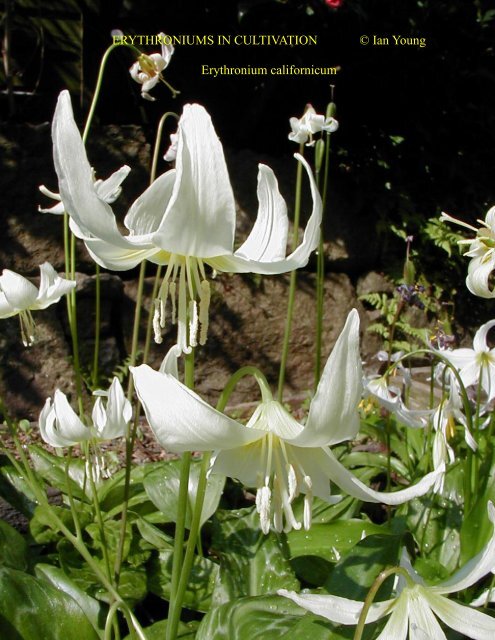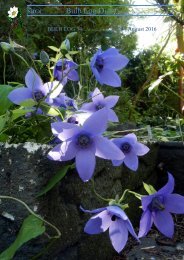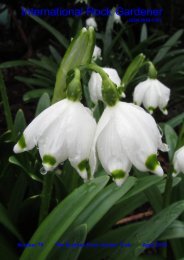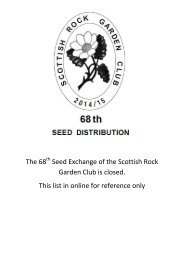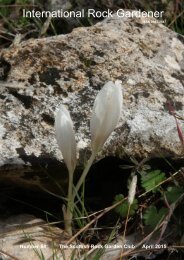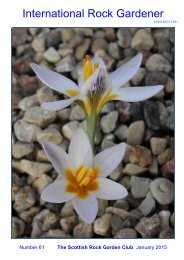ERYTHRONIUMS IN CULTIVATION Erythronium californicum © Ian Young
2015Dec161450265242BULB_LOG_5015
2015Dec161450265242BULB_LOG_5015
You also want an ePaper? Increase the reach of your titles
YUMPU automatically turns print PDFs into web optimized ePapers that Google loves.
<strong>ERYTHRONIUMS</strong> <strong>IN</strong> <strong>CULTIVATION</strong><br />
<strong>ERYTHRONIUMS</strong> <strong>IN</strong> <strong>CULTIVATION</strong><br />
<strong>Erythronium</strong> <strong>californicum</strong><br />
<strong>©</strong> <strong>Ian</strong> <strong>Young</strong><br />
<strong>©</strong> <strong>Ian</strong> <strong>Young</strong>
<strong>ERYTHRONIUMS</strong> <strong>IN</strong> <strong>CULTIVATION</strong><br />
<strong>©</strong> <strong>Ian</strong> <strong>Young</strong><br />
<strong>Erythronium</strong> <strong>californicum</strong><br />
<strong>Erythronium</strong> <strong>californicum</strong> filaments are narrow, ribbon-like with milky white pollen , the flowers are also creamy<br />
white with a yellow centre; some forms have dark red zig zag patterns around the centre.<br />
<strong>Erythronium</strong> <strong>californicum</strong> is another excellent<br />
garden plant which is most often seen under the<br />
cultivar name of <strong>Erythronium</strong> ‘White Beauty’ this<br />
is readily available.<br />
I include ‘White Beauty’ here, rather than under<br />
hybrids, as there are no morphological indications<br />
that any other species is involved.<br />
What makes this form such a good garden plant is<br />
its ability to tolerate a wide range of garden types<br />
and increase well by division: a healthy wellgrown<br />
bulb can make two new flowering sized<br />
bulbs plus have several smaller offsets every year<br />
– it also regularly sets seed.<br />
<strong>Erythronium</strong> ‘White Beauty’
<strong>ERYTHRONIUMS</strong> <strong>IN</strong> <strong>CULTIVATION</strong><br />
<strong>©</strong> <strong>Ian</strong> <strong>Young</strong><br />
<strong>Erythronium</strong><br />
<strong>californicum</strong><br />
All forms are free<br />
flowering, setting seed<br />
most years provided the<br />
weather conditions at<br />
flowering time are not too<br />
cold and wet.<br />
<strong>Erythronium</strong> ‘White<br />
Beauty’ has fewer seeds<br />
in the capsule compared<br />
to other forms; about one<br />
third of the number.<br />
<strong>Erythronium</strong> <strong>californicum</strong> seeds
<strong>ERYTHRONIUMS</strong> <strong>IN</strong> <strong>CULTIVATION</strong><br />
<strong>©</strong> <strong>Ian</strong> <strong>Young</strong><br />
Bulb<br />
On the left is a group of<br />
<strong>Erythronium</strong><br />
<strong>californicum</strong> bulbs<br />
showing the typical<br />
shape – the longer thin<br />
ones are younger bulbs<br />
still taking themselves<br />
down into the ground<br />
seeking the best<br />
conditions.<br />
Most forms will increase<br />
by offsets, soon forming<br />
clumps – forms such as<br />
‘White Beauty’ form<br />
clumps quickly, see<br />
below, and are best lifted<br />
and divided every three<br />
to five years to maintain<br />
good flowering.<br />
<strong>Erythronium</strong> <strong>californicum</strong><br />
<strong>Erythronium</strong> ‘White Beauty’ bulbs with multiple offsets.
<strong>ERYTHRONIUMS</strong> <strong>IN</strong> <strong>CULTIVATION</strong><br />
<strong>©</strong> <strong>Ian</strong> <strong>Young</strong><br />
<strong>Erythronium</strong> ‘White Beauty’<br />
Leaves<br />
The leaves are very<br />
similar to those of<br />
<strong>Erythronium</strong> revolutum<br />
and <strong>Erythronium</strong><br />
oregonum with varying<br />
degrees of dark<br />
markings - the best of<br />
which can be very<br />
dramatic.
<strong>ERYTHRONIUMS</strong> <strong>IN</strong> <strong>CULTIVATION</strong><br />
<strong>©</strong> <strong>Ian</strong> <strong>Young</strong><br />
A group of seedlings showing variation in the leaf pattern some with more dark areas than others.<br />
Here is a clone selected from <strong>Erythronium</strong><br />
‘White Beauty’ seedlings which had darker<br />
marked leaves than the parent and was<br />
more vigorous perhaps as it was a much<br />
younger clone.<br />
I distributed this form under the name<br />
<strong>Erythronium</strong> ‘Craigton Beauty’.<br />
<strong>Erythronium</strong> <strong>californicum</strong> is an excellent<br />
garden plant that is easy to grow, easy to<br />
get hold of plus it also increases well.
<strong>ERYTHRONIUMS</strong> <strong>IN</strong> <strong>CULTIVATION</strong><br />
<strong>©</strong> <strong>Ian</strong> <strong>Young</strong><br />
<strong>Erythronium</strong> <strong>californicum</strong><br />
It should be noted when raising <strong>Erythronium</strong> <strong>californicum</strong><br />
from seed that you should check the resulting seedlings<br />
carefully when they first flower as it is a promiscuous species,<br />
hybridising readily with many other Western North American<br />
species.<br />
Such hybrids can be very attractive, in fact many make very<br />
good garden plants as they can grow in an even wider range of<br />
garden and weather conditions than the pure species.<br />
<strong>Erythronium</strong> <strong>californicum</strong>
<strong>ERYTHRONIUMS</strong> <strong>IN</strong> <strong>CULTIVATION</strong><br />
<strong>ERYTHRONIUMS</strong> <strong>IN</strong> <strong>CULTIVATION</strong><br />
<strong>©</strong> <strong>Ian</strong> <strong>Young</strong><br />
<strong>©</strong> <strong>Ian</strong> <strong>Young</strong><br />
<strong>Erythronium</strong> citrinum
<strong>ERYTHRONIUMS</strong> <strong>IN</strong> <strong>CULTIVATION</strong><br />
<strong>©</strong> <strong>Ian</strong> <strong>Young</strong><br />
<strong>Erythronium</strong> citrinum<br />
<strong>Erythronium</strong><br />
citrinum is one of a<br />
number of<br />
<strong>Erythronium</strong>s that<br />
are basically white<br />
with a yellow<br />
centre.<br />
This would not be<br />
among the first<br />
species I would<br />
recommend to the<br />
regular gardener :<br />
<strong>Erythronium</strong><br />
oregonum and<br />
<strong>Erythronium</strong><br />
<strong>californicum</strong><br />
provide similar<br />
colours and are<br />
more robust garden<br />
plants, however for<br />
the enthusiastic<br />
growers<br />
<strong>Erythronium</strong><br />
citrinum is a<br />
charming species.<br />
<strong>Erythronium</strong> citrinum has white flowers, with some degree of citrus yellow colour towards the centre with matching<br />
white pollen – the filaments are narrow and there are swollen appendages at the base of the petals.<br />
The species that it is most likely to be confused with is <strong>Erythronium</strong> howellii which shares most of the same<br />
features but does<br />
not possess the<br />
swollen<br />
appendages.<br />
<strong>Erythronium</strong> citrinum<br />
<strong>Erythronium</strong> howellii<br />
On the right are<br />
one inner and one<br />
outer floral<br />
segment from both<br />
<strong>Erythronium</strong><br />
citrinum and<br />
<strong>Erythronium</strong><br />
howellii with the<br />
swollen structure<br />
on the former<br />
circled.
<strong>ERYTHRONIUMS</strong> <strong>IN</strong> <strong>CULTIVATION</strong><br />
<strong>©</strong> <strong>Ian</strong> <strong>Young</strong><br />
<strong>Erythronium</strong> citrinum<br />
<strong>Erythronium</strong> howellii<br />
Another difference I have noted is in the shape of the flowers - when they are open <strong>Erythronium</strong> citrinum flowers<br />
open wider revealing more of the stamens, style and ovary when viewed from the side while the base of<br />
<strong>Erythronium</strong> howellii always remains more bell-like, wrapped around these parts of the flower.<br />
<strong>Erythronium</strong> citrinum<br />
<strong>Erythronium</strong> howellii<br />
Looking at the two species in flower you become able to tell them apart from the shape of the flower and a quick<br />
check inside for the presence or absence of the swollen appendages will confirm which species it is.
<strong>ERYTHRONIUMS</strong> <strong>IN</strong> <strong>CULTIVATION</strong><br />
<strong>©</strong> <strong>Ian</strong> <strong>Young</strong><br />
Seed<br />
Seed is the best way to increase this species and you can expect around thirty seeds from a well fertilised capsule.<br />
I store the seed dry in paper packets over the summer, ideally sowing it at the end of August after soaking it<br />
overnight. Above you see the same seed as in the previous picture which has now been been soaked ready for<br />
sowing – In the picture below is the resulting germination the following spring.
<strong>ERYTHRONIUMS</strong> <strong>IN</strong> <strong>CULTIVATION</strong><br />
<strong>©</strong> <strong>Ian</strong> <strong>Young</strong><br />
<strong>Erythronium</strong> howellii and <strong>Erythronium</strong> citrinum seedlings photographed on 30 th April 2015.<br />
Bulb<br />
A group of<br />
typical<br />
<strong>Erythronium</strong><br />
citrinum bulbs –<br />
you will note<br />
that there are no<br />
new offsets just<br />
the remains of<br />
the previous<br />
year’s growth<br />
attached at the<br />
base of the new<br />
bulb. In my<br />
experience this<br />
is another<br />
species that<br />
does not<br />
increase readily<br />
by division.
<strong>ERYTHRONIUMS</strong> <strong>IN</strong> <strong>CULTIVATION</strong><br />
<strong>©</strong> <strong>Ian</strong> <strong>Young</strong><br />
Leaves<br />
<strong>Erythronium</strong> citrinum leaves
<strong>ERYTHRONIUMS</strong> <strong>IN</strong> <strong>CULTIVATION</strong><br />
<strong>©</strong> <strong>Ian</strong> <strong>Young</strong><br />
<strong>Erythronium</strong> citrinum
<strong>ERYTHRONIUMS</strong> <strong>IN</strong> <strong>CULTIVATION</strong><br />
<strong>©</strong> <strong>Ian</strong> <strong>Young</strong><br />
<strong>Erythronium</strong> citrinum var roderickii<br />
A number of years ago a new variety was named<br />
<strong>Erythronium</strong> citrinum var roderickii after the late<br />
Wayne Roderick: its distinguishing feature is the<br />
dark anthers which reveal brown pollen when they<br />
dehisce. I find this to be the most beautiful variation.<br />
I have seen a number of plants of <strong>Erythronium</strong><br />
citrinum in the UK which, on close inspection, appear<br />
to be hybrids, many have dark pattern lines around<br />
the central yellow zone – these plants do clump up<br />
quite well.<br />
<strong>Erythronium</strong> citrinum is a relatively easily grown<br />
species and being that bit smaller in stature is ideally<br />
suited to growing among smaller plants on our rock<br />
garden.
<strong>ERYTHRONIUMS</strong> <strong>IN</strong> <strong>CULTIVATION</strong><br />
<strong>©</strong> <strong>Ian</strong> <strong>Young</strong><br />
<strong>Erythronium</strong> citrinum
<strong>ERYTHRONIUMS</strong> <strong>IN</strong> <strong>CULTIVATION</strong><br />
<strong>ERYTHRONIUMS</strong> <strong>IN</strong> <strong>CULTIVATION</strong><br />
<strong>©</strong> <strong>Ian</strong> <strong>Young</strong><br />
<strong>©</strong> <strong>Ian</strong> <strong>Young</strong><br />
<strong>Erythronium</strong> howellii
<strong>ERYTHRONIUMS</strong> <strong>IN</strong> <strong>CULTIVATION</strong><br />
<strong>©</strong> <strong>Ian</strong> <strong>Young</strong><br />
<strong>Erythronium</strong> howellii<br />
<strong>Erythronium</strong> howellii<br />
<strong>Erythronium</strong> howellii has a white flower with a yellow<br />
central zone and is very similar to <strong>Erythronium</strong> citrinum –<br />
the key differences are that the swollen appendages on the<br />
petals are absent on this species and also in the way the<br />
flower opens, see under <strong>Erythronium</strong> citrinum for more<br />
details.
<strong>ERYTHRONIUMS</strong> <strong>IN</strong> <strong>CULTIVATION</strong><br />
<strong>©</strong> <strong>Ian</strong> <strong>Young</strong><br />
<strong>Erythronium</strong> howellii<br />
The flowers are white to<br />
creamy white as are the<br />
anthers and pollen -<br />
varying degrees of<br />
yellow in the throat give<br />
it an attractive<br />
appearance.<br />
As with many white<br />
flowers they often take<br />
on a pink colour as they<br />
age and the<br />
anthocyanins develop.
<strong>ERYTHRONIUMS</strong> <strong>IN</strong> <strong>CULTIVATION</strong><br />
<strong>©</strong> <strong>Ian</strong> <strong>Young</strong><br />
Seed<br />
Seed freshly harvested from the garden<br />
will be stored in paper packets before it<br />
is soaked and sown towards the end of<br />
the summer.<br />
The same seed is now soaked<br />
and ready for sowing and below<br />
are the seedlings germinating the<br />
following April.<br />
<strong>Erythronium</strong> howellii seedlings
<strong>ERYTHRONIUMS</strong> <strong>IN</strong> <strong>CULTIVATION</strong><br />
<strong>©</strong> <strong>Ian</strong> <strong>Young</strong><br />
Mature plants of<br />
<strong>Erythronium</strong> howellii<br />
will have mutiple<br />
flowers on a stem; we<br />
mostly get four in our<br />
garden.<br />
This is another<br />
species that offers no<br />
real difficulties<br />
growing in a number<br />
of beds in our garden<br />
but like <strong>Erythronium</strong><br />
citrinum it is best<br />
suited to the beds<br />
containg smaller<br />
plants.<br />
<strong>Erythronium</strong> howellii
<strong>ERYTHRONIUMS</strong> <strong>IN</strong> <strong>CULTIVATION</strong><br />
<strong>©</strong> <strong>Ian</strong> <strong>Young</strong><br />
<strong>Erythronium</strong> howellii


